Chemical Characterization of Pope Pius VII Ancient Ecclesiastical Vestment by a Multi-Analytical Approach
Abstract
:1. Introduction
2. Materials and Methods
2.1. In Situ Analytical Methods
2.2. Laboratory Analyses
3. Results and Discussion
3.1. Multiband Imaging (MBI)
3.2. XRF Elemental Analysis
3.3. SEM-EDS, FT-IR, MicroRAMAN, GC/MS Survey: Micro-Analysis on Fragments
4. Conclusions
Author Contributions
Funding
Institutional Review Board Statement
Informed Consent Statement
Acknowledgments
Conflicts of Interest
Appendix A
Appendix A.1. Historical Notes about the Papal Clothing and Don Saverio Caselli
Appendix A.2. Description of the Artifacts
Appendix A.3. Decoration and Iconography
Appendix A.4. The Conservation Treatment
Appendix A.5. The State of Conservation
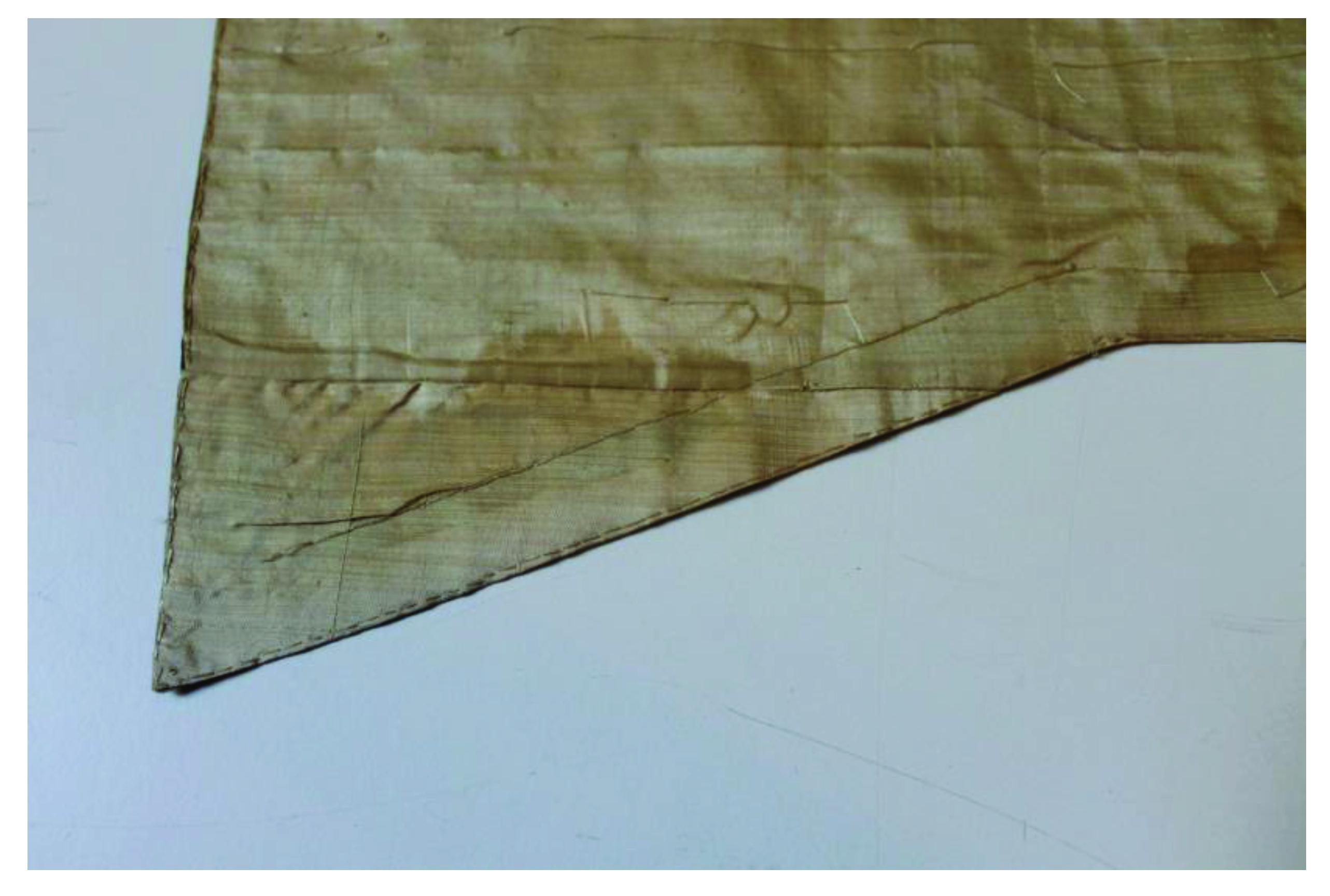
Appendix A.6. Conservation Operations
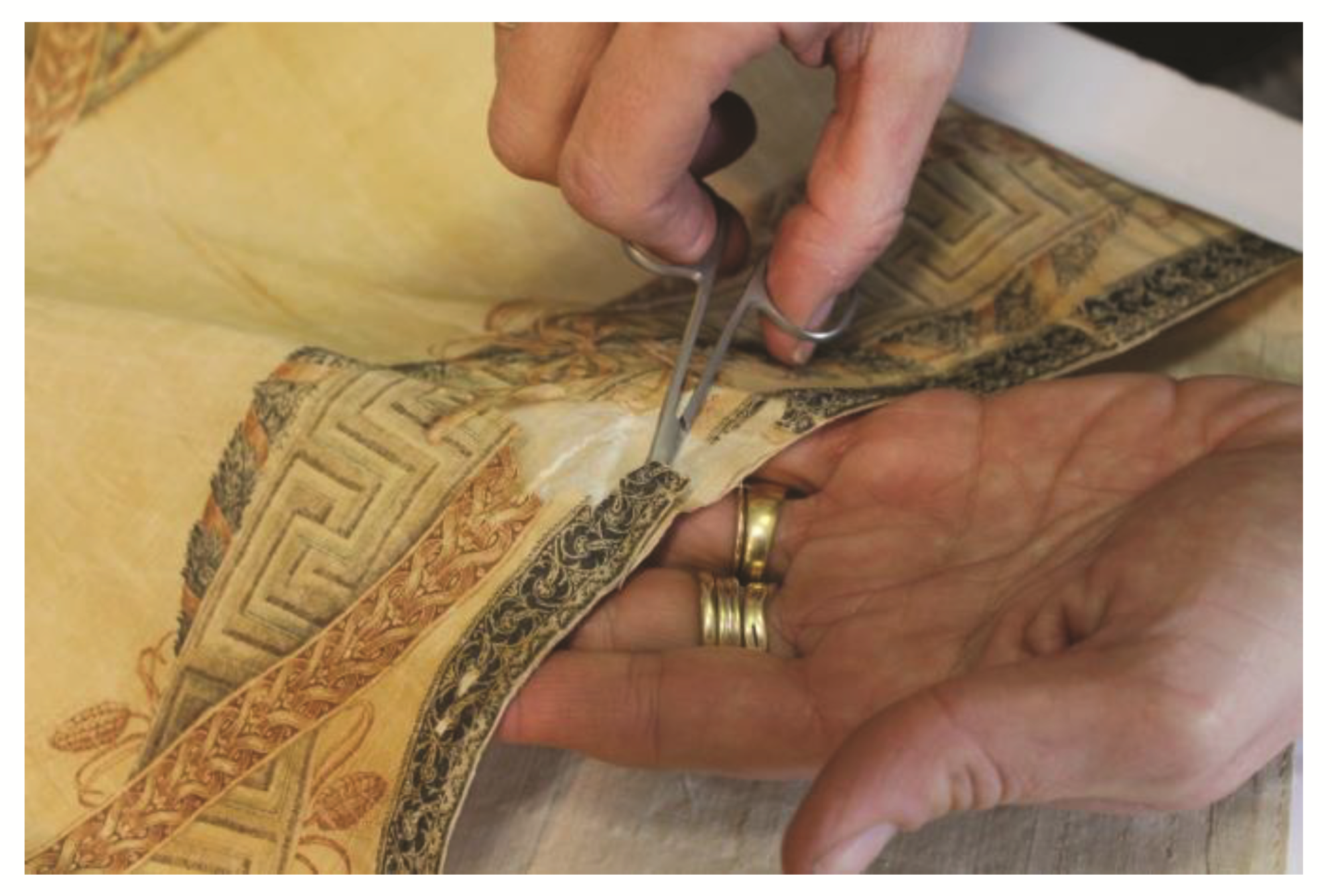
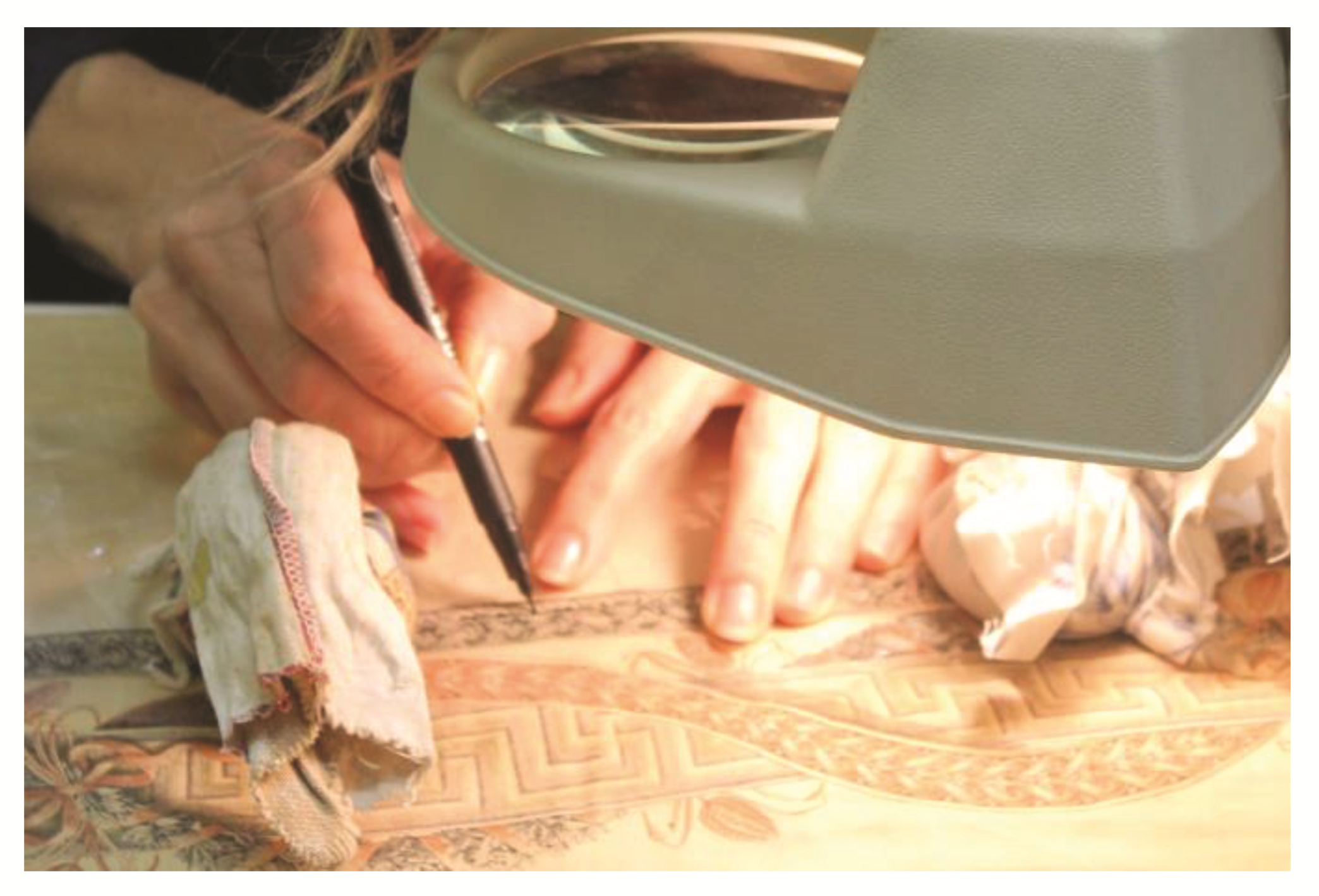
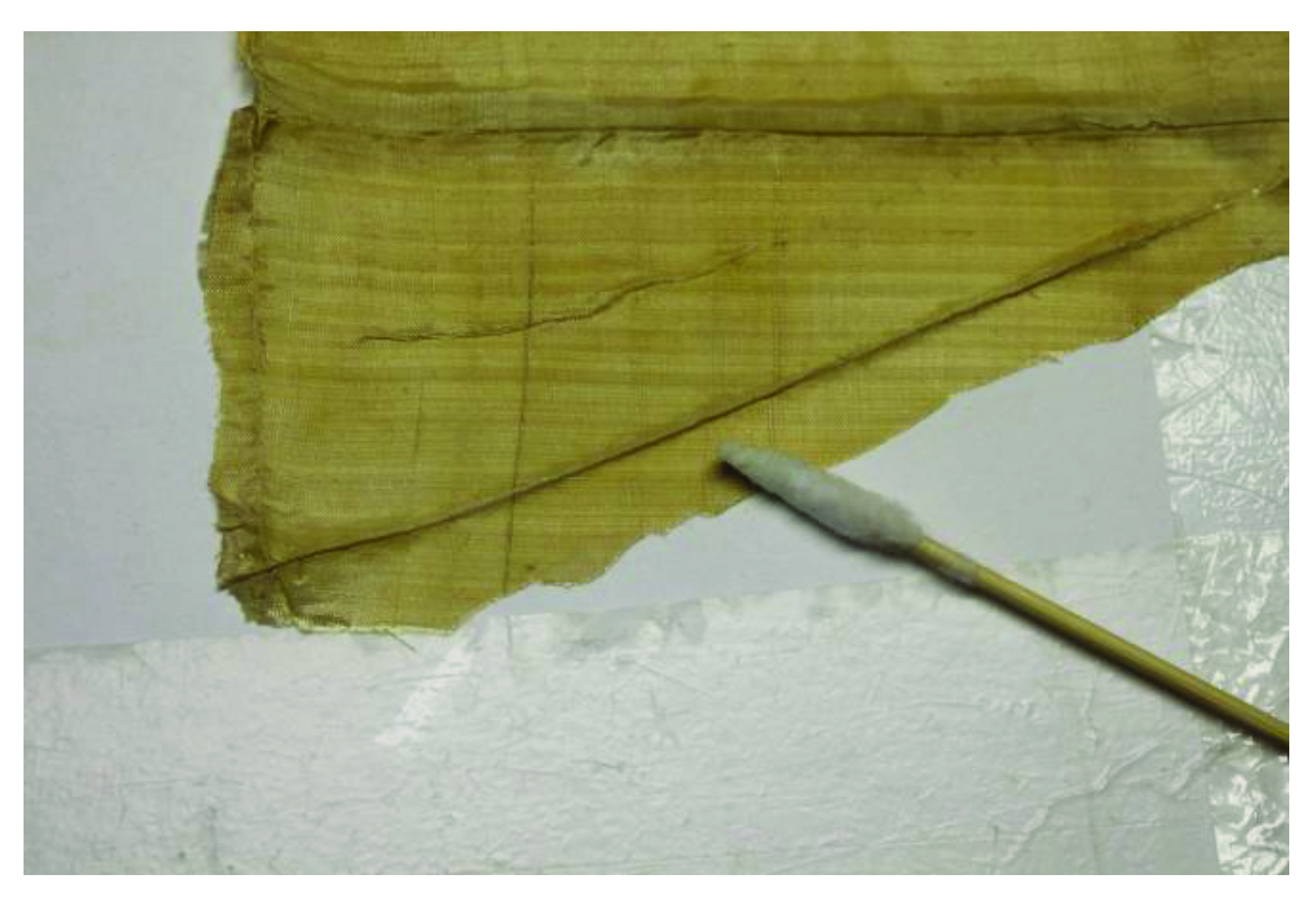
References
- Di Lazzaro, P.; Guarneri, M.; Murra, D.; Spizzichino, V.; Danielis, A.; Mencattini, A.; Piraccini, V.; Missori, M. Noninvasive analyses of low-contrast images on ancient textiles: The case of the Shroud of Arquata. J. Cult. Herit. 2016, 17, 14–19. [Google Scholar] [CrossRef]
- Ferreira, T.; Moreiras, H.; Manhita, A.; Tomaz, P.; Mirão, J.; Dias, C.B.; Caldeira, A.T. The Liturgical Cope of D. Teotónio of Braganza: Material Characterization of a 16th Century Pluviale. Microsc. Microanal. 2014, 21, 2–14. [Google Scholar] [CrossRef] [PubMed]
- Amorello, D.; Barreca, S.; Bruno, M.; Milia, A.; Orecchio, S.; Pettignano, A. Chemical characterization of ancient liturgical vestment (chasuble) by Inductively Coupled Plasma–Optical Emission Spectrometry (ICP–OES). Microchem. J. 2016, 129, 305–309. [Google Scholar] [CrossRef]
- Šimić, K.; Zamboni, I.; Fazinić, S.; Mudronja, D.; Sović, L.; Gouasmia, S.; Soljačić, I. Comparative analysis of textile metal threads from liturgical vestments and folk costumes in Croatia. Nucl. Instrum. Methods Phys. Res. Sect. B Beam Interact. Mater. At. 2018, 417, 115–120. [Google Scholar] [CrossRef]
- Pelosi, C.; Falletta, G.; De Dominicis, B.; Baraldi, P. The Painted Silk Panels of Palazzo Barberini at Rome. The Scientific Investigation and Preservation Challenge. Procedia Chem. 2013, 8, 248–257. [Google Scholar] [CrossRef] [Green Version]
- Fedi, M.; Cartocci, A.; Taccetti, F.; Mando, P.A. AMS radiocarbon dating of medieval textile relics: The frocks and the pillow of St. Francis of Assisi. Nucl. Instrum. Methods Phys. Res. Sect. B Beam Interact. Mater. At. 2008, 266, 2251–2254. [Google Scholar] [CrossRef]
- Witkowski, B.; Ganeczko, M.; Hryszko, H.; Stachurska, M.; Gierczak, T.; Biesaga, M. Identification of orcein and selected natural dyes in 14th and 15th century liturgical paraments with high-performance liquid chromatography coupled to the electrospray ionization tandem mass spectrometry (HPLC-ESI/MS/MS). Microchem. J. 2017, 133, 370–379. [Google Scholar] [CrossRef]
- Theile, J.M.; Guarda, S.O.S.G.; Croquevielle, E. Analysis conservation and restoration of the metal threads used in Latin American colonial saints’ robes. In Proceedings of Metal; National Museum of Australia: Canberra, Australia, 2004; pp. 501–513. [Google Scholar]
- Muros, V.; Wärmländer, S.K.; Scott, D.A.; Theile, J.M. Characterization of 17Th-19Th Century Metal Threads from the Colonial Andes. J. Am. Inst. Conserv. 2007, 46, 229–244. [Google Scholar] [CrossRef]
- Olaru, A.; Geba, M.; Vlad, A.M.; Ciovică, S. Metallic accessories on ethnographic textiles deterioration problems. Eur. J. Sci. Theol. 2013, 9, 177–186. [Google Scholar]
- Edwards, H.G.M.; Farwell, D.W.; Perez, F.R.; Garcia, J.M. Mediaeval cantorals in the Valladolid Biblioteca: FT-Raman spectroscopic study. Analyst 2001, 126, 383–388. [Google Scholar] [CrossRef]
- Lech, K. Dataset supporting the identification of natural dyes in yellow, orange, brown and green fibres from Krakow liturgical vestments. Data Brief 2020, 31, 105735. [Google Scholar] [CrossRef]
- Thompson, K.; Smith, M.; Lennard, F. A literature review of analytical techniques for materials characterisation of painted textiles—Part 1: Categorising painted textiles, sampling and the use of optical tools. J. Inst. Conserv. 2017, 40, 64–82. [Google Scholar] [CrossRef] [Green Version]
- Degano, I.; Ribechini, E.; Modugno, F.; Colombini, M.P. Analytical Methods for the Characterization of Organic Dyes in Artworks and in Historical Textiles. Appl. Spectrosc. Rev. 2009, 44, 363–410. [Google Scholar] [CrossRef]
- Bonizzoni, L.; Bruni, S.; Fanti, G.; Tiberio, P.; Zaffino, C. Ageing of flax textiles: Fingerprints in micro-Raman spectra of single fibres. Microchem. J. 2016, 125, 69–74. [Google Scholar] [CrossRef]
- Gulmini, M.; Idone, A.; Davit, P.; Moi, M.; Carrillo, M.; Ricci, C.; Bello, F.D.; Borla, M.; Oliva, C.; Greco, C.; et al. The “Coptic” textiles of the “Museo Egizio” in Torino (Italy): A focus on dyes through a multi-technique approach. Archaeol. Anthr. Sci. 2017, 9, 485–497. [Google Scholar] [CrossRef]
- Gulmini, M.; Idone, A.; Diana, E.; Gastaldi, D.; Vaudan, D.; Aceto, M. Identification of dyestuffs in historical textiles: Strong and weak points of a non-invasive approach. Dye. Pigment. 2013, 98, 136–145. [Google Scholar] [CrossRef]
- Angelini, L.G.; Tozzi, S.; Bracci, S.; Quercioli, F.; Radicati, B.; Picollo, M. Characterization of traditional dyes of the mediterranean area by non-invasive UV-VIS-NIR reflectance spectroscopy. Stud. Conserv. 2010, 55, 184–189. [Google Scholar] [CrossRef]
- Dyer, J.; Tamburini, D.; O’Connell, E.R.; Harrison, A. A multispectral imaging approach integrated into the study of Late Antique textiles from Egypt. PLoS ONE 2018, 13, e0204699. [Google Scholar] [CrossRef] [PubMed] [Green Version]
- Klisińska-Kopacz, A. Non-destructive characterization of 17th century painted silk banner by the combined use of Raman and XRF portable systems. J. Raman Spectrosc. 2015, 46, 317–321. [Google Scholar] [CrossRef]
- Christiansen, T.; Buti, D.; Dalby, K.; Lindelof, P.E.; Ryholt, K.; Vila, A. Chemical characterization of black and red inks inscribed on ancient Egyptian papyri: The Tebtunis temple library. J. Archaeol. Sci. Rep. 2017, 14, 208–219. [Google Scholar] [CrossRef]
- Piccolo Paci, S. Storia delle Vesti Liturgiche. Forma, Immagine e Funzione, Ancora; Still: Milano, Italy, 2008. [Google Scholar]
- Available online: https://collections.vam.ac.uk/item/O353313/vestments-unknown (accessed on 8 March 2021).
- Dyer, J.; Verri, G.; Cupitt, J. Multispectral Imaging in Reflectance and Photo-induced Luminescence modes: A User Manual. 2013. Available online: https://www.researchgate.net/publication/267266175_Multispectral_Imaging_in_Reflectance_and_Photo-induced_Luminescence_modes_A_User_Manual (accessed on 8 March 2021).
- Cosentino, A. Infrared Technical Photography for Art Examination. e-Preserv. Sci. 2016, 13, 1–6. [Google Scholar]
- Shugar, A.N.; Mass, J.L. Handheld XRF for Art and Archaeology; Leuven University Press: Leuven, Belgium, 2013; ISBN 9789058679079. [Google Scholar]
- Bezur, A.; Lee, L.; Loubser, M.; Trentelman, K. Handheld XRF in Cultural Heritage. A Practical Workbook for Conservators; J. Paul Getty Trust and Yale University: Los Angeles, CA, USA, 2020; ISBN 978-1-937433-61-1. (online resource). [Google Scholar]
- Derrick, M.R.; Stulik, D.C.; Landry, J.M. Infrared Spectroscopy in Conservation Science. Scientific Tools for Conservation; Getty Conservation Institute: Los Angeles, CA, USA, 1999; Available online: http://hdl.handle.net/10020/gci_pubs/infrared_spectroscopy (accessed on 8 March 2021).
- Garside, P.; Lahlil, S.; Wyeth, P. Characterization of Historic Silk by Polarized Attenuated Total Reflectance Fourier Transform Infrared Spectroscopy for Informed Conservation. Appl. Spectrosc. 2005, 59, 1242–1247. [Google Scholar] [CrossRef] [PubMed]
- Kavkler, K.; Gunde-Cimerman, N.; Zalar, P.; Demšar, A. FTIR spectroscopy of biodegraded historical textiles. Polym. Degrad. Stab. 2011, 96, 574–580. [Google Scholar] [CrossRef]
- Luo, X.; Wu, J.; Intisar, A.; Geng, J.; Wu, L.; Zheng, K.; Du, Y. Study on Light Aging of Silk Fabric by Fourier Transform Infrared Spectroscopy and Principal Component Analysis. Anal. Lett. 2012, 45, 1286–1296. [Google Scholar] [CrossRef]
- Edwards, H.G.M.; Wyeth, P. Ancient Textile Fibres. In Raman Spectroscopy in Archaeology and Art History; Edwards, H.G.M., Chalmers, J.M., Eds.; The Royal Society of Chemistry: Cambridge, UK, 2005; pp. 304–324. [Google Scholar]
- Bell, I.M.; Clark, R.J.; Gibbs, P.J. Raman spectroscopic library of natural and synthetic pigments (pre- ≈ 1850 AD). Spectrochim. Acta Part A Mol. Biomol. Spectrosc. 1997, 53, 2159–2179. [Google Scholar] [CrossRef]
- Lluveras-Tenorio, A.; Bonaduce, I.; Andreotti, A.; Colombini, M.P. GC/MS Analytical Procedure for the Characterization of Glycerolipids, Natural Waxes, Terpenoid Resins, Proteinaceous and Polysaccharide Materials in the Same Paint Microsample Avoiding Interferences from Inorganic Media. Anal. Chem. 2010, 82, 376–386. [Google Scholar] [CrossRef]
- Tamburini, D.; Dyer, J. Fibre optic reflectance spectroscopy and multispectral imaging for the non-invasive investigation of Asian colourants in Chinese textiles from Dunhuang (7th–10th century AD). Dye. Pigment. 2019, 162, 494–511. [Google Scholar] [CrossRef]
- Fischer, C.; Kakoulli, I. Multispectral and hyperspectral imaging technologies in conservation: Current research and potential applications. Stud. Conserv. 2006, 51, 3–16. [Google Scholar] [CrossRef]
- Hain, M.; Bartl, J.; Jacko, V. Multispectral analysis of cultural heritage artefacts. Meas. Sci. Rev. 2003, 3, 9–12. [Google Scholar]
- Havermans, J.; Aziz, H.A.; Scholten, H. Non Destructive Detection of Iron Gall Inks by Means of Multispectral Imaging Part 1: Development of the Detection System. Restaurator 2003, 24, 55–60. [Google Scholar] [CrossRef]
- Havermans, J.; Aziz, H.A.; Scholten, H. Non Destructive Detection of Iron-Gall Inks by Means of Multispectral Imaging Part 2: Application on Original Objects Affected With Iron-Gall-Ink Corrosion. Restaurator 2003, 24, 88–94. [Google Scholar] [CrossRef]
- Cosentino, A. Practical notes on ultraviolet technical photography for art examination. Conserv. Patrimoacute 2015, 21, 53–62. [Google Scholar] [CrossRef] [Green Version]
- Mairinger, F. The ultraviolet and fluorescence study of paintings and manuscripts. In Radiation in Art and Archeometry; Creagh, D.C., Bradley, D.A., Eds.; Elsevier Science: Amsterdam, The Netherlands, 2000; pp. 56–75. ISBN 9780444504876. [Google Scholar]
- Becker, M.A.; Magoshi, Y.; Sakai, T.; Tuross, N.C. Chemical and physical properties of old silk fabrics. Stud. Conserv. 1997, 42, 27–37. [Google Scholar] [CrossRef]
- Vilaplana, F.; Nilsson, J.; Sommer, D.V.P.; Karlsson, S. Analytical markers for silk degradation: Comparing historic silk and silk artificially aged in different environments. Anal. Bioanal. Chem. 2014, 407, 1433–1449. [Google Scholar] [CrossRef] [Green Version]
- Winter, J. The characterization of pigments based on carbon. Stud. Conserv. 1983, 28, 49–66. [Google Scholar] [CrossRef]
- Hinrichs, R.; Vasconcellos, M.A.Z.; Österle, W.; Prietzel, C. Amorphization of Graphite Flakes in Gray Cast Iron under Tribological Load. Mater. Res. 2018, 21, e2017100. [Google Scholar] [CrossRef]
- Froment, F.; Tournié, A.; Colomban, P. Raman identification of natural red to yellow pigments: Ochre and iron-containing ores. J. Raman Spectrosc. 2008, 39, 560–568. [Google Scholar] [CrossRef]
- Tomasini, E.P.; Halac, E.B.; Reinoso, M.; Di Liscia, E.J.; Maier, M.S. Micro-Raman spectroscopy of carbon-based black pigments. J. Raman Spectrosc. 2012, 43, 1671–1675. [Google Scholar] [CrossRef]
- Ferrari, A.C.; Robertson, J. Interpretation of Raman spectra of disordered and amorphous carbon. Phys. Rev. B 2000, 61, 14095–14107. [Google Scholar] [CrossRef] [Green Version]
- Goler, S.; Hagadorn, A.; Ratzan, D.M.; Bagnall, R.; Cacciola, A.; McInerney, J.; Yardley, J.T. Using Raman spectroscopy to estimate the dates of carbon-based inks from Ancient Egypt. J. Cult. Herit. 2019, 38, 106–117. [Google Scholar] [CrossRef]
- Goler, S.; Yardley, J.T.; Cacciola, A.; Hagadorn, A.; Ratzan, D.; Bagnall, R. Characterizing the age of ancient Egyptian manuscripts through micro-Raman spectroscopy. J. Raman Spectrosc. 2016, 47, 1185–1193. [Google Scholar] [CrossRef]
- Lluveras-Tenorio, A.; Mazurek, J.; Restivo, A.; Colombini, M.P.; Bonaduce, I. Analysis of plant gums and saccharide materials in paint samples: Comparison of GC-MS analytical procedures and databases. Chem. Cent. J. 2012, 6, 115. [Google Scholar] [CrossRef] [PubMed] [Green Version]
- Bonaduce, I.; Ribechini, E.; Modugno, F.; Colombini, M.P. Analytical Approaches Based on Gas Chromatography Mass Spectrometry (GC/MS) to Study Organic Materials in Artworks and Archaeological Objects. Top. Curr. Chem. 2016, 374, 1–37. [Google Scholar] [CrossRef] [PubMed]
- Beyeler, C. Les ambiguïtés du Salon à Paris: Romains aux Tuileries et Français à Saint-Pierre. In Pie VII Face à Napoléon. La Tiare dans les Serres de l’Aigle; Beyeler, C., Hebert, J.F., Droguet, V., Eds.; RMN: Paris, France, 2015; pp. 147–153. ISBN 10271186247X. [Google Scholar]
- Beyeler, C. Rome-Paris-Fontainebleau, 1796–1814, direction scientifique du catalogue et rédaction de deux essais: Concurrence entre Rome et Paris. Mises en image rivales du Concordat. In Pie VII Face à Napoléon. La Tiare dans les Serres de l’Aigle; Beyeler, C., Hebert, J.F., Droguet, V., Eds.; RMN: Paris, France, 2015; pp. 53–57. ISBN 10271186247X. [Google Scholar]
- Del Prete, R. Piccole Tessitrici Operose. Gli Orfanotrofi Femminili a Benevento; Franco Angeli: Milano, Italy, 2010; p. 108. ISBN 978-8856832082. [Google Scholar]
| 1 | “IHS (or JHS) is a Latin transcription of the Greek abbreviation of the name of Jesus ᾿Ιησοῦς, capital ΙHΣOΥΣ) as written in Greek manuscripts or inscriptions. Reading the H (η) like an h originated the erroneous interpretation of the script, like Jesus Hominum Salvator. Such a script was spread in Italy and Spain from the 14th to the second half of the 15th century, in particular by the work of Bernardino da Siena and followers, who, as a symbol of a particular devotion to Jesus’ name, took it as an emblem, surrounded by rays and with a vertical addition to the middle bar of the H to form a cross. Ignatius de Loyola adopted it, surmounted by a cross, as an emblem of the Jesus Congregation (Enciclopedia Treccani). “Contrary to popular opinion, the monogram does not indicate “Jesus Hominum Salvator” or “In Hoc Signo”. IHS is more appropriately defined as “crystogram”, or an antique way of writing “Jesus Christ” originating in the 3rd century. The Christians abbreviated Jesus’ name, writing only the first three Greek letters ΙHΣ (from the complete name ΙHΣOΥΣ). The Greek letter Σ (sigma) in the Latin alphabet became a “S”, and this originated the script ΙHS. In the first centuries in the church, this was a secret symbol, often carved in the tombs of the Christians. After, in the 15th century, Saint Bernardine of Siena organized a preaching campaign to promote the reverence to the holy name of Jesus and encouraged the Christians to put a HIS over the door of their houses. A century after, in 1541, Saint Ignatius adopted the monogram to represent his newly founded order, the Jesus Society (Jesuits). The symbol is now widespread in all the Christian areas of the world”, Philip Kosloski, in Aleteia, 16 May 2017. |


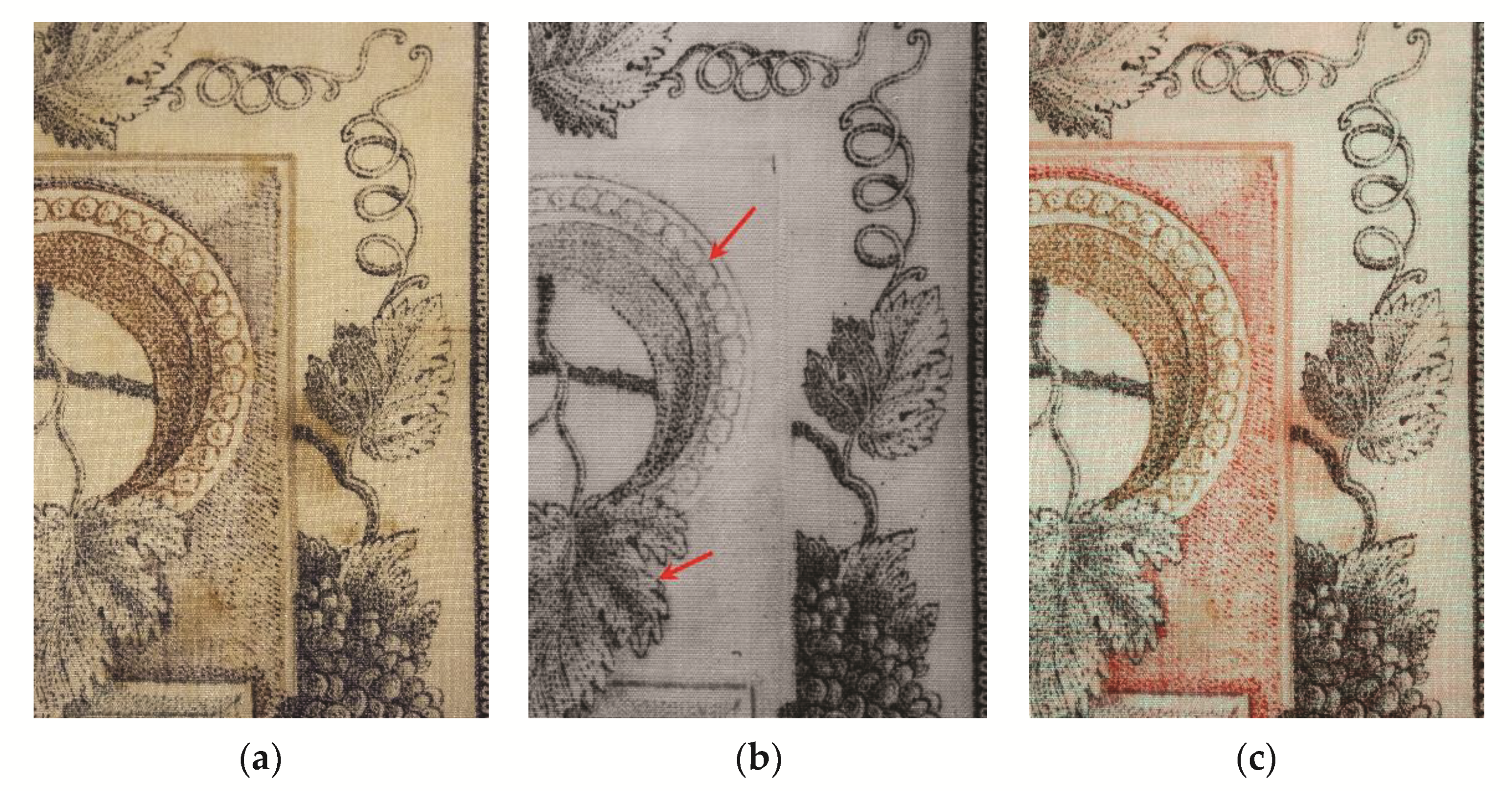
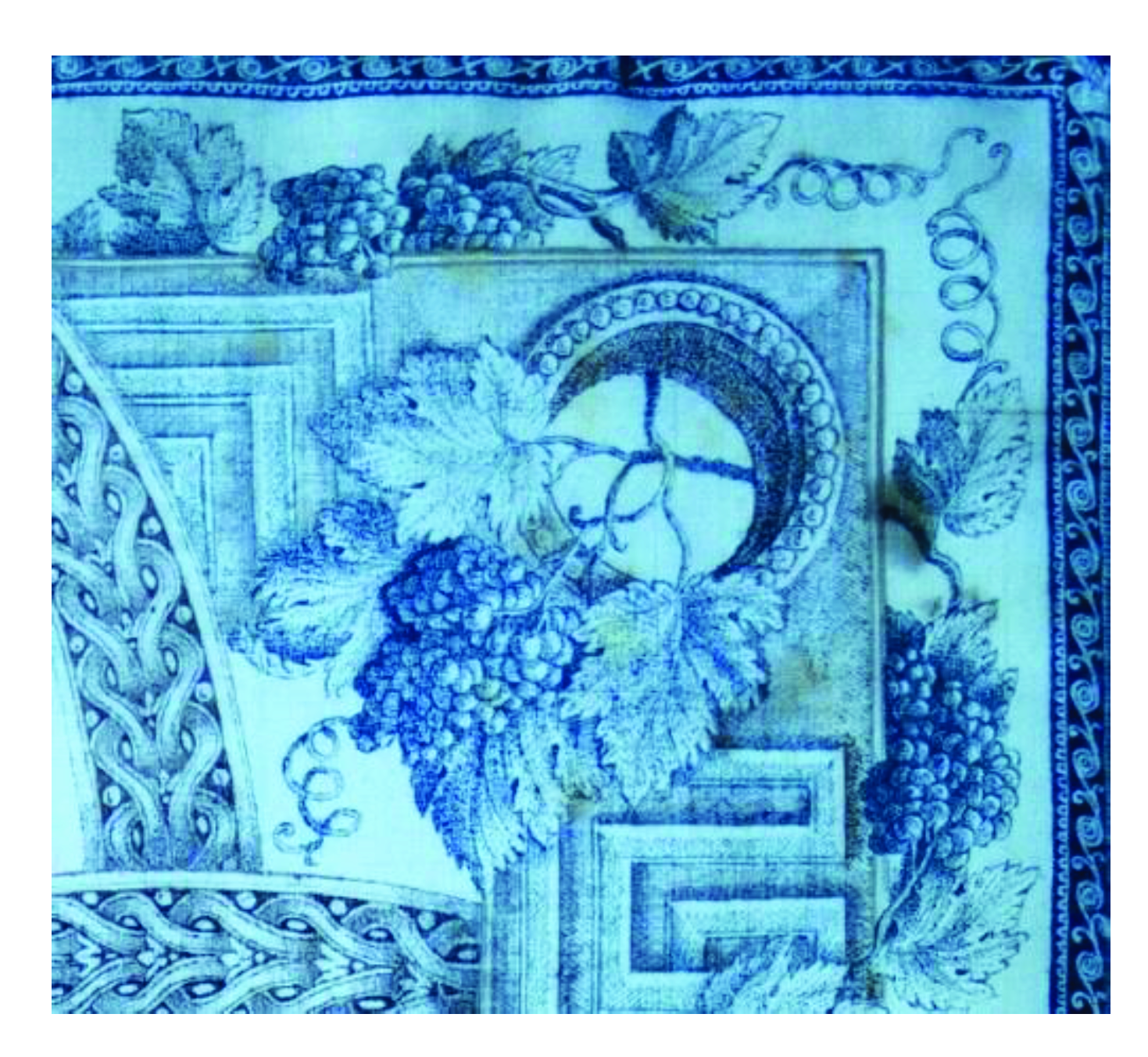

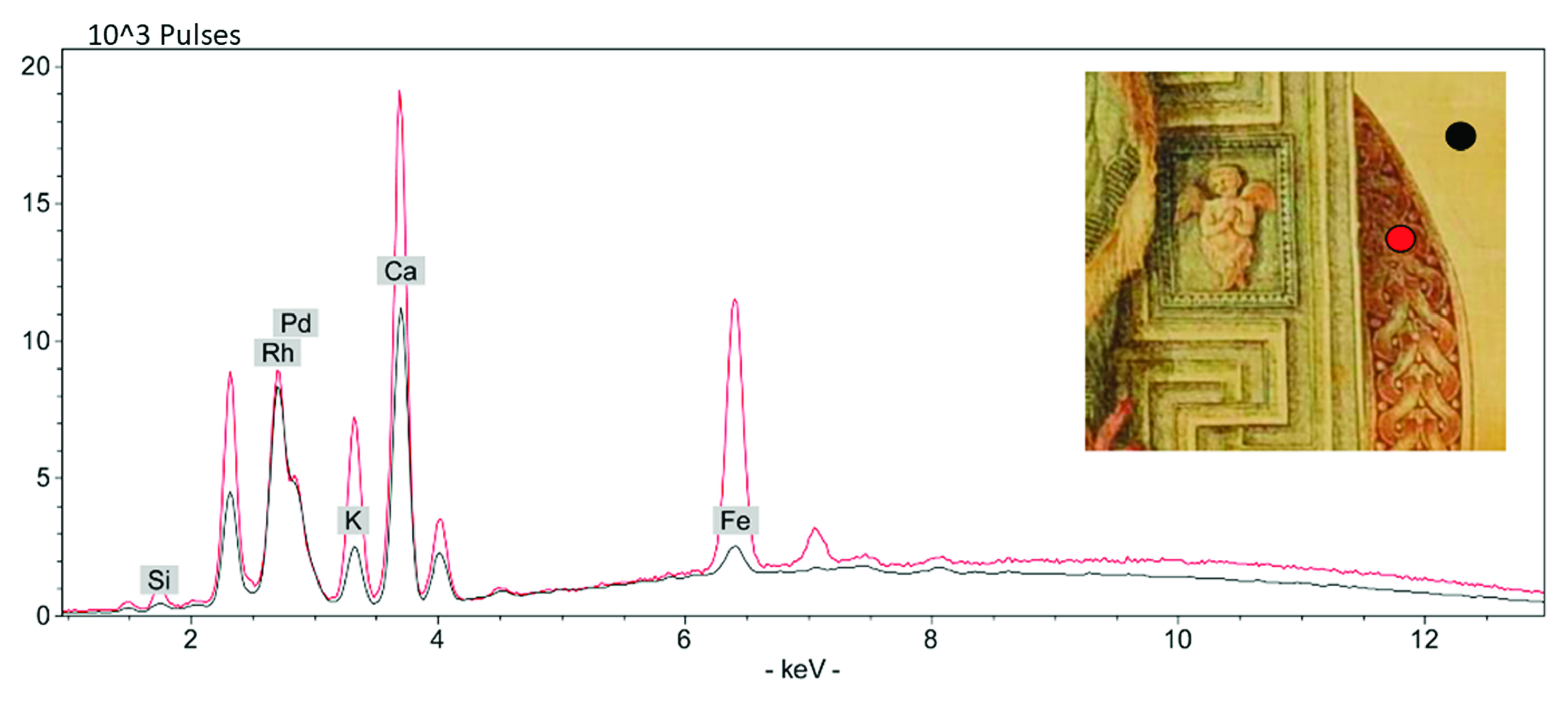
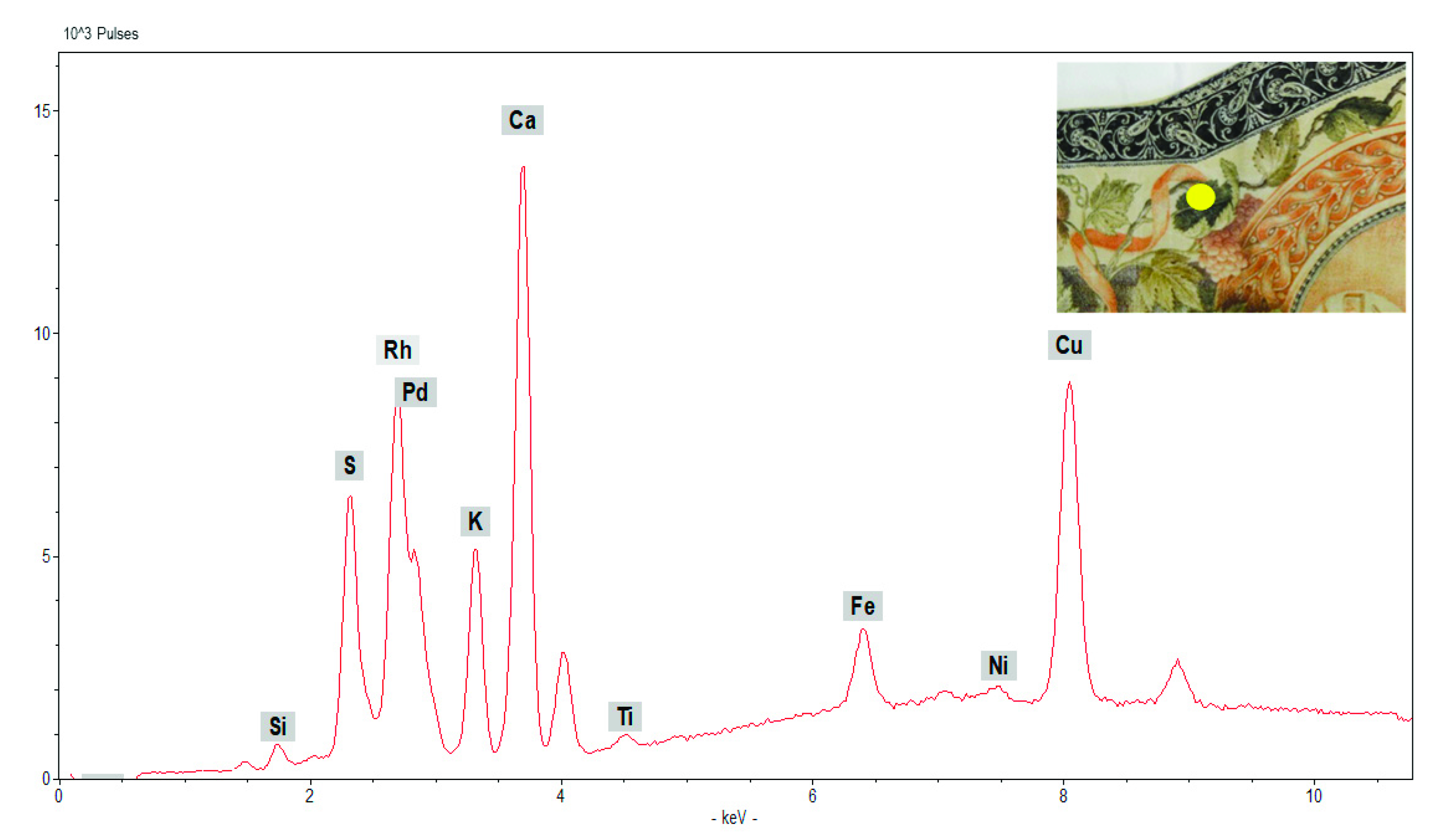


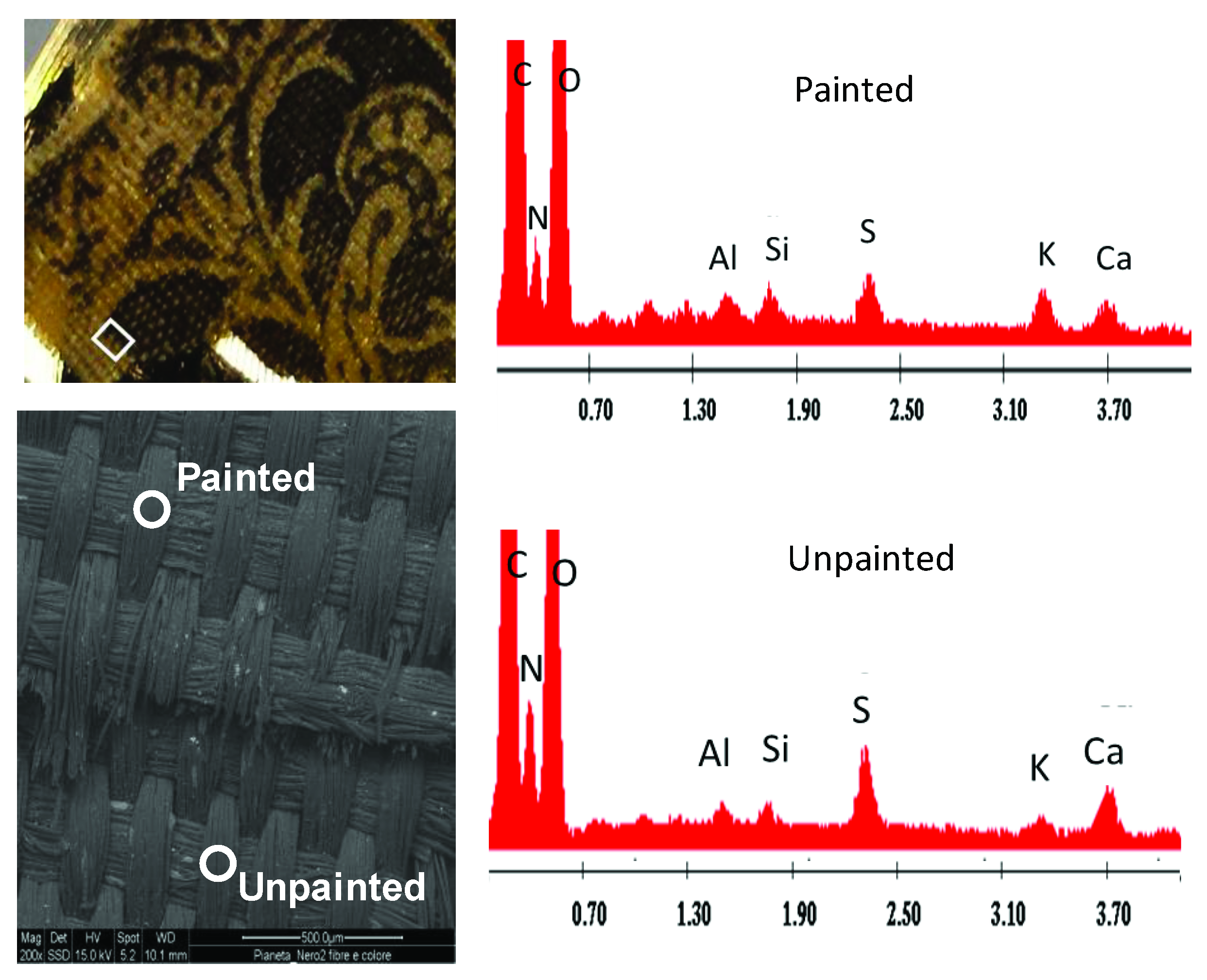
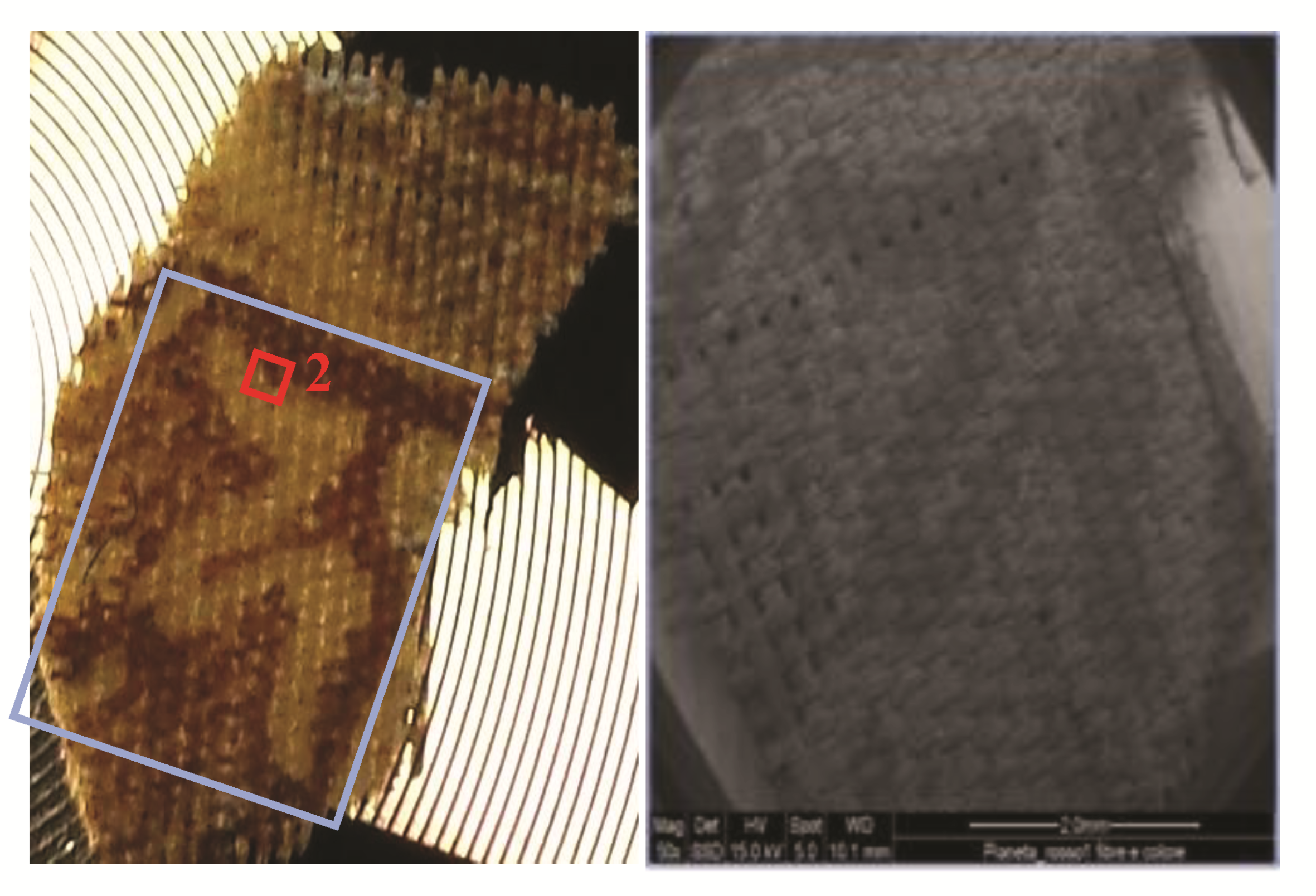
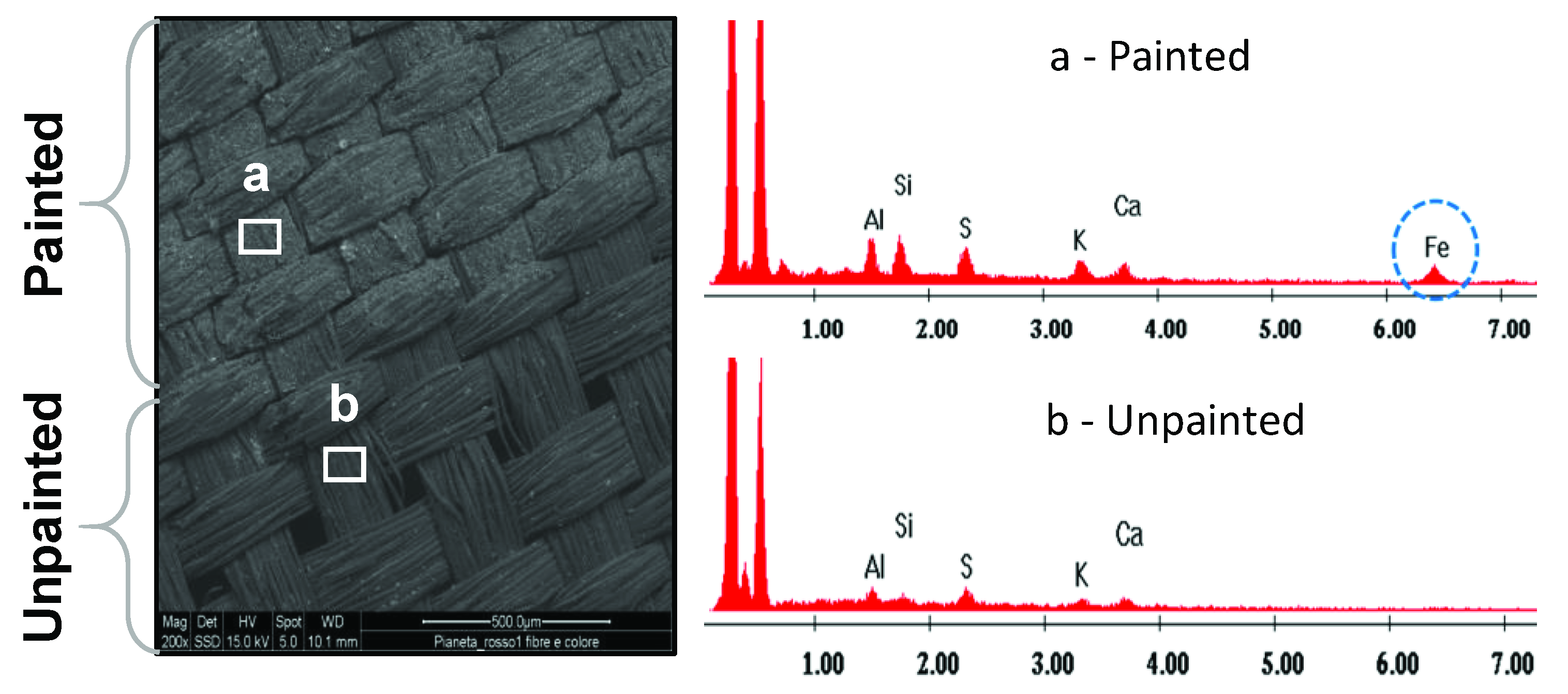
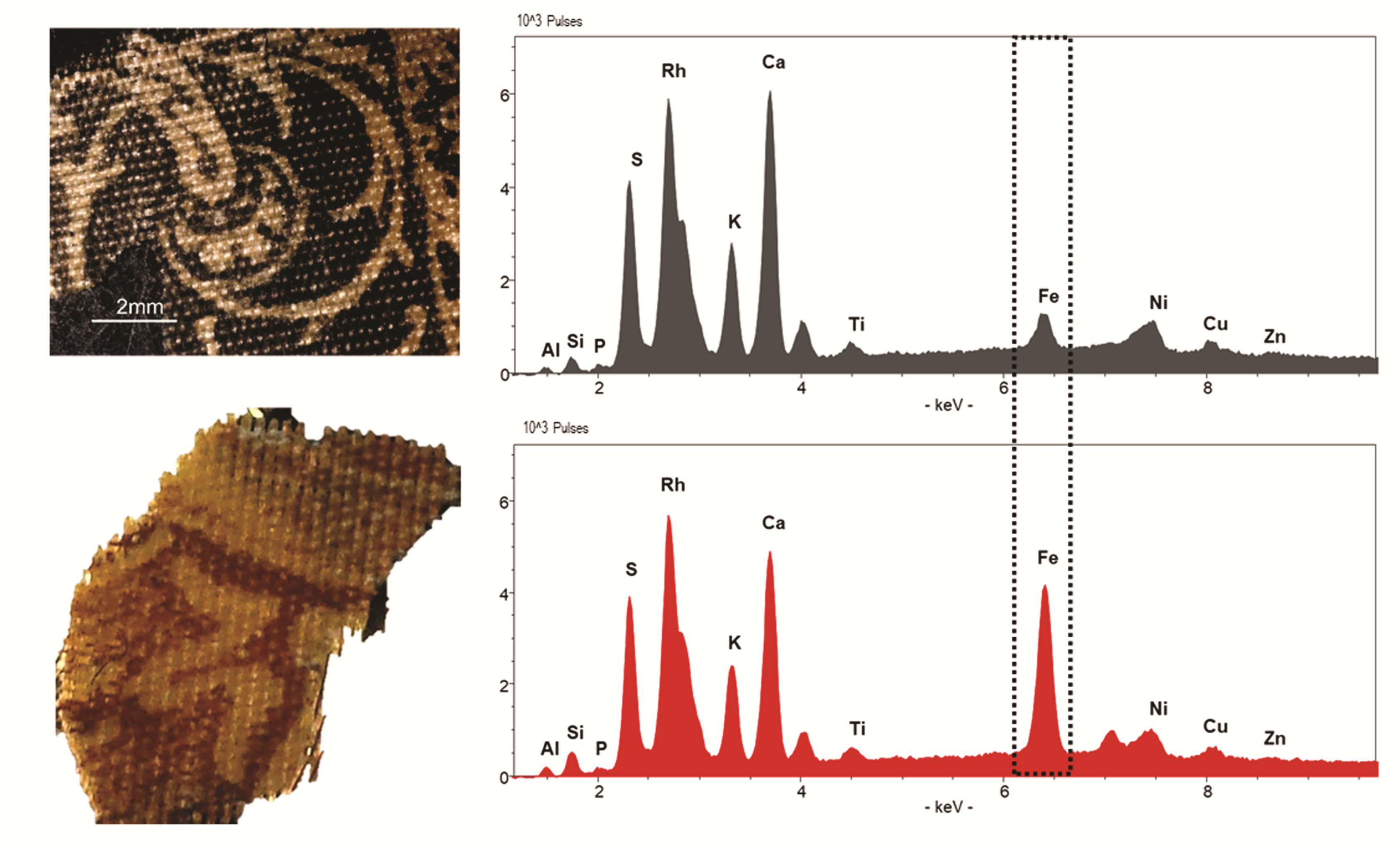

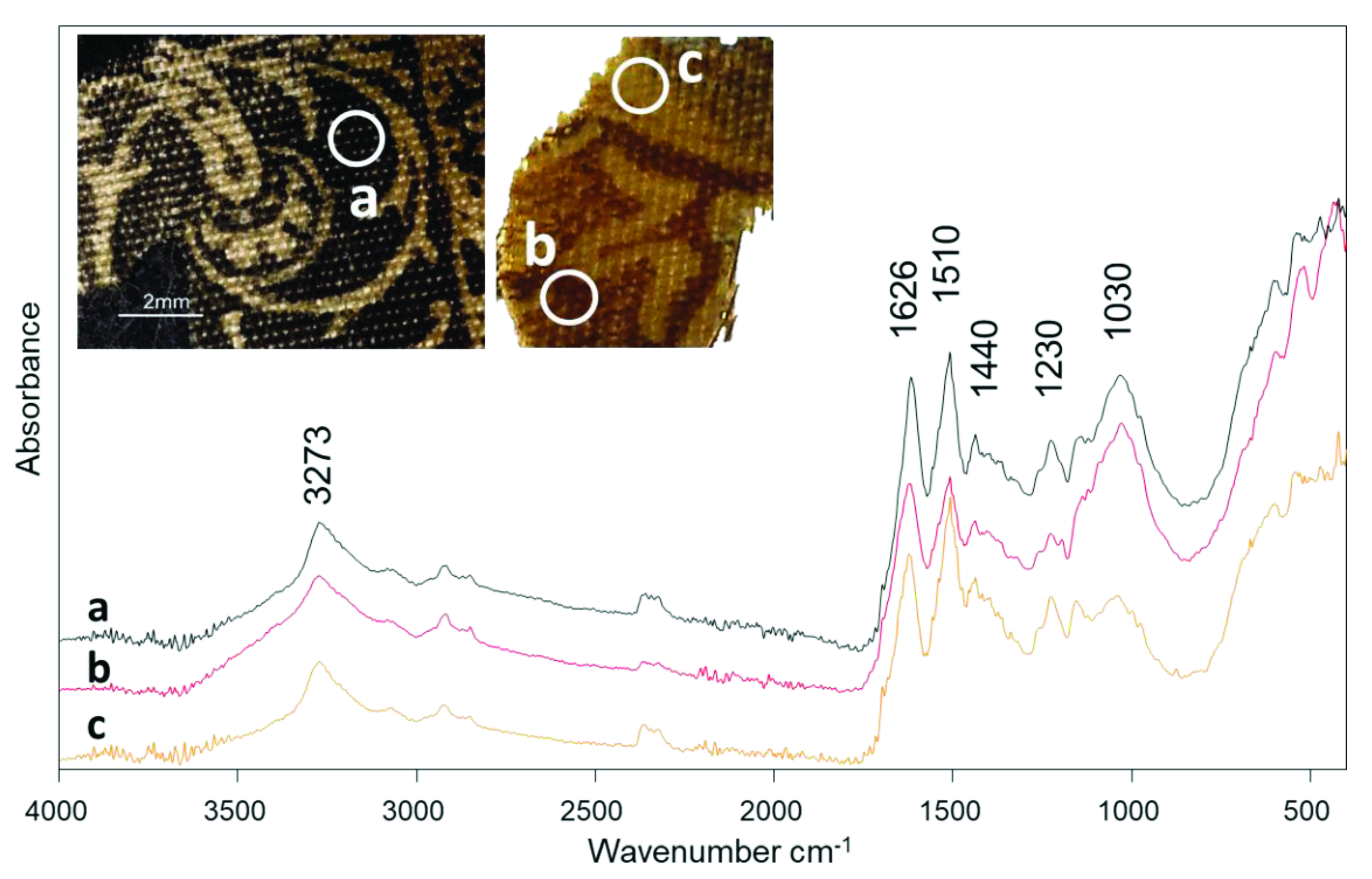
| Technique | Camera | Filters on Flashes | Filter on Camera |
|---|---|---|---|
| UVL | CANON EOS 7D | B+W 403 UV black | B+W 468 UV/IR cut |
| VIS | CANON EOS 7D | B+W 468 UV/IR cut | B+W 468 UV/IR cut |
| NIR | CANON EOS 400D | B+W 093 IR | B+W 093 IR |
| Sample | Xilose | Arabinose | Rhamnose | Fucose | Galacturonic Acid | Glucuronic Acid | Glucose | Mannose | Galactose | Saccharide Content(µg) |
|---|---|---|---|---|---|---|---|---|---|---|
| RS | - | 33 | 12 | - | - | 11 | - | - | 44 | 1.6 |
| BS | - | 39 | 12 | - | - | 8 | - | - | 41 | 2.4 |
Publisher’s Note: MDPI stays neutral with regard to jurisdictional claims in published maps and institutional affiliations. |
© 2021 by the authors. Licensee MDPI, Basel, Switzerland. This article is an open access article distributed under the terms and conditions of the Creative Commons Attribution (CC BY) license (https://creativecommons.org/licenses/by/4.0/).
Share and Cite
Magrini, D.; Bracci, S.; Iannaccone, R.; Nucci, L.; Salvadori, B. Chemical Characterization of Pope Pius VII Ancient Ecclesiastical Vestment by a Multi-Analytical Approach. Heritage 2021, 4, 1616-1638. https://doi.org/10.3390/heritage4030090
Magrini D, Bracci S, Iannaccone R, Nucci L, Salvadori B. Chemical Characterization of Pope Pius VII Ancient Ecclesiastical Vestment by a Multi-Analytical Approach. Heritage. 2021; 4(3):1616-1638. https://doi.org/10.3390/heritage4030090
Chicago/Turabian StyleMagrini, Donata, Susanna Bracci, Roberta Iannaccone, Lucia Nucci, and Barbara Salvadori. 2021. "Chemical Characterization of Pope Pius VII Ancient Ecclesiastical Vestment by a Multi-Analytical Approach" Heritage 4, no. 3: 1616-1638. https://doi.org/10.3390/heritage4030090
APA StyleMagrini, D., Bracci, S., Iannaccone, R., Nucci, L., & Salvadori, B. (2021). Chemical Characterization of Pope Pius VII Ancient Ecclesiastical Vestment by a Multi-Analytical Approach. Heritage, 4(3), 1616-1638. https://doi.org/10.3390/heritage4030090







